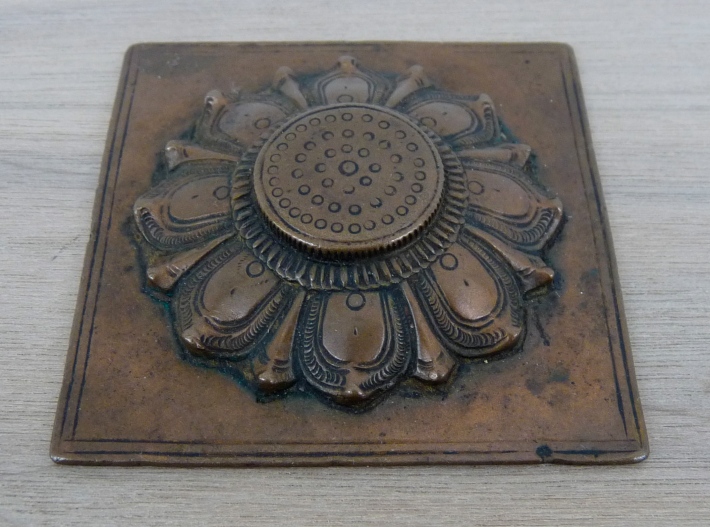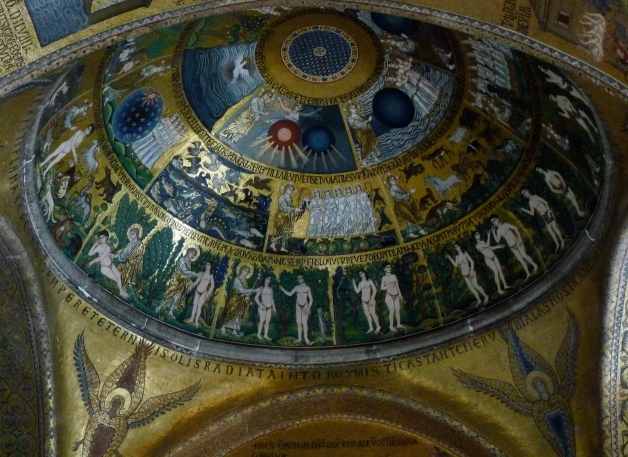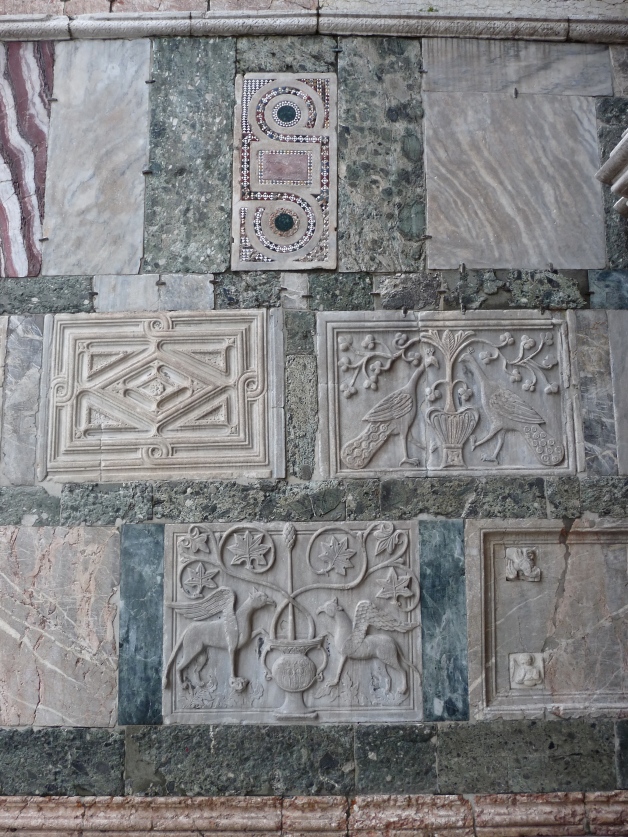Here’s a link to Open Doors Gallery’s online art ‘zine, this month featuring a short article I wrote about the impact of trade on Dutch culture and still life paintings. Scroll sideways to find the article, entitled Story Behind the Image. And, yes, I am aware that I have been completely upstaged by a piece about the penile proportions of classical statuary. Now why didn’t I think of that?
Indian Tantric & Western Contemporary
This fascinating exhibition, a collaboration between Joost van den Bergh and Bartha Contemporary, is on view until 23 March. It juxtaposes Indian spiritual and ceremonial pieces with works by Western contemporary artists, drawing surprising connections between these distinct artistic traditions.
Tantraism is a far-reaching philosophy, and one that has had great impact upon the spiritual landscape of India, influencing the rituals and beliefs of Buddhism, Hinduism and Jainism among other religions. Proponents of tantra utilise mantras (spoken words and phrases) and yantras (instruments or symbolic diagrams) in their attempts to perceive the true reality. Many of the pieces on display here are yantras, which vary from complex pen-and-ink diagrams to small bronze plaques, all carefully ordered into symmetrical, geometric forms.
These are objects intended to be intensely considered, objects which even offer to improve the viewer through close contemplation – aims shared by many contemporary works of art. Here, the inclusion of Winston Roeth’s Black / Green Square, 2004, emphasises the rewards of such sustained observation, as the iridescent green surface constantly shifts under our scrutiny, offering a new image with each fresh point-of-view. This mesmerising effect is achieved through countless layers of paint, applied free-hand with extraordinary accuracy, again evoking the prolonged concentration necessary for tantric practices.
Such practices are intensely ritualistic, often requiring the same actions or words to be repeated with an almost obsessive devotion. These ideas of ritual and repetition are explored in the works of Stefana McClure, here represented with the 2008 piece, South Pacific: Closed captions to a film by J. Logan. One of a series of similar works, McClure has here created an image by tracing the subtitles and closed captions of a foreign language film onto a sheet of blue transfer paper. The resultant marks are entirely obscure, as the process of overlaying the different traced text has rendered the familiar letters unrecognisable, subverting their original function of clarification.
Severed from their original context, many of the Indian tantric pieces themselves feel fairly obscure, as the Western contemporary viewer struggles to read their mystical signs and geometric symbols, or truly understand their ritual and spiritual functions. Such mystery and magic, however, is part of their charm, and certainly one reason why tantraism has so long fascinated the West – the other of course being its association with sexuality. Here, re-imagined as contemporary art objects in a gallery, these pieces have regained their place in a world of meditation and ritual, albeit of a very different kind.
‘Extraordinary Stories about Ordinary Things’ – the New Permanent Collection Gallery at the Design Museum
Here is my review of the new permanent collection gallery at the Design Museum. The collection obviously includes some interesting pieces, but the overall structure of the exhibition is weak at best. There are also some bizarre curatorial decisions – in particular championing luxurious and rarified objects in an exhibition that claims to represent ‘ordinary things.’ To be honest, I would postpone a visit until 2014, when the collection will be available to view free of charge at the Design Museum’s new home on Kensington High Street. Certainly, the ticket price of £11.80 doesn’t represent good value in a city where the majority of museums (including the design powerhouse that is the V&A) are free.
Venice and the East – Basilica San Marco
Better known today as a tourist destination, Venice was once one of the most important commercial centres in Europe. Situated at the cusp of the Near East, it had strong trade links not only with Italy to the West, and Germany to the North, but also to the Byzantine and later Ottoman Empires to the East. Indeed, before Vasco de Gama rounded the Cape of Good Hope in 1497, opening up the possibility of direct maritime trade with Asia, most Eastern goods arriving in Europe passed through Venice. These strong mercantile ties with the East are still visible in the city today, reflected in the architecture, for example in the use of ogival arches. This arch is from the facade of Basilica San Marco, but the form can be seen adorning countless Venetian palazzi.
Death: A Self Portrait at the Wellcome Collection
This quirky exhibition is at once a testament to one man’s obsession and an exploration of that most universal of human themes: death. It displays some 300 pieces from the private collection of Richard Harris, all linked through their treatment of the iconography of death, a concept most commonly expressed here through skulls, skeletons and decomposing bodies. These repeated motifs certainly lend an overarching coherence to the collection, lending a commonality to works from disparate periods and places, and creating the sense of death as a universal theme.
Despite this, certain historical milieu dominate, and death ultimately appears as a concept that has held more importance for some cultural groups than others, for example appearing more regularly in the art of the Northern Renaissance than in it’s Italian counterpart. Perhaps for this reason, many of the more artistically important items in the collection are Germanic or Netherlandish, with an elaborate vanitas still life by Adriaen van Utrecht and a portrait by Barthel Bruyn the Elder, painted on the reverse with a skull and a mometo mori, among the more sophisticated pieces. Albrecht Dürer’s work is also well represented, alluding both to a particular preoccupation with death in the tumultuous world of reformation Germany, and to Harris’ own past as a dealer of antique prints.
Another period in which Harris shows particular interest is the Weimar era, when artists so recently exposed to the horrors of the First World War struggled to reconcile their newly intimate knowledge of death and the human body with their return to civilian life. Their responses vary from George Grosz’s ‘Faces of Death’ collage (above), which wittily intersperses skulls into scenes of every day life, to the gory horror of Otto Dix’s ‘War’ series, which depicts the trauma of trench warfare with an unflinching brutality (below).
Despite this more in depth analysis of certain periods’ attitudes towards death, ultimately the exhibition’s treatment of this subject feels a little superficial. It is impossible to stand before the war inspired art of Dix and Goya and feel unmoved by humanity’s fragility, but other pieces on display lack the same impact. Whilst a skull might have evoked profound feelings of dread to a devout sixteenth century German, used to high infant mortality and mass epidemics and concerned about the ever-lasting welfare of his soul, to a modern audience the skull has become little more than an empty symbol. In our own society we all too often brush death and dying aside, and as such it is hard to empathise with a culture like the German Renaissance, where death was an accepted and expected side of life.
The popular image of death as a skull or skeleton continues to hold sway today, and could even be said to be going through something of a resurgence, with blogs like morbid anatomy feeding a desire for the macabre, and hipsters emulating a Mexican, day of the dead aesthetic each Halloween. However, this fashionable adoption of the iconography of death often feels false, as we struggle to believe that a fashionista’s skull print Alexander McQueen scarf truly betrays a morbid disposition. Ultimately this is the undoing of the exhibition, as without our own way of connecting to the reality of death, this exploration of morbid iconography becomes little more than a collection of painted skulls.
Exquisite Antonio Susini Mother and Child sells for £480,000
This stunning bronze group of the Virgin and Child, c.1610-20, sold at Christie’s yesterday for over £480,000. Previously undocumented, it is one of four examples of this composition which are believed to be the work of Antonio Susini (died 1624). Susini is better known as a technical assistant and caster to the great master Giambalogna (1529-1608) than as a sculptor in his own right, and it is fascinating to see here a work that he conceived and executed by himself. Although Susini’s work remained under the influence of his master, even after he left to establish his own workshop in 1600, there is nothing derivative or reductive about his pieces. Indeed, works such as this one prove him to be an accomplished sculptor, deserving of his own recognition. The piece shows great technical ability in the detail of the casting, for example in the finely modelled faces and carefully articulated curls of the Virgin and Child. However, Susini was not merely a talented technician, and details such as the drapery, which moves from the heavy, sweeping folds of the over skirt, to the gently fluttering, delicate material around the Virgin’s feet, suggest a real confidence and mastery of the medium. Particularly charming is the contrast between the monumental solemnity of the Virgin, and the vitality of her son, who seems almost about to wriggle from her arms. Such liveliness emphasises the humanity of the Christ child, an idea also alluded to here by the careful depiction of his fleshy, childish physiognomy.












